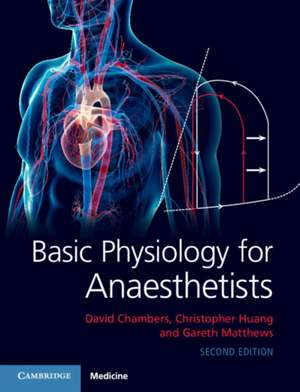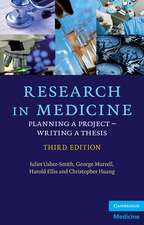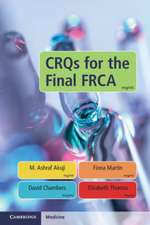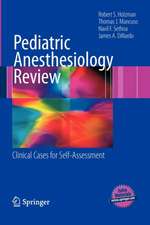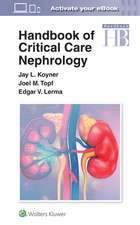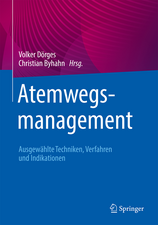Basic Physiology for Anaesthetists
Autor David Chambers, Christopher Huang, Gareth Matthewsen Limba Engleză Paperback – 24 iul 2019
Preț: 430.19 lei
Preț vechi: 452.82 lei
-5% Nou
82.33€ • 85.63$ • 67.97£
Carte disponibilă
Livrare economică 22 martie-05 aprilie
Livrare express 11-15 martie pentru 51.42 lei
Specificații
ISBN-10: 1108463991
Pagini: 464
Ilustrații: 152 b/w illus. 7 tables
Dimensiuni: 190 x 246 x 22 mm
Greutate: 1 kg
Ediția:2Revizuită
Editura: Cambridge University Press
Colecția Cambridge University Press
Locul publicării:Cambridge, United Kingdom
Cuprins
Forward Russell Perkins; Preface to the first edition; Preface to the second edition; Part I. The Basics: 1. General organisation of the body; 2. Cell components and function; 3. Genetics; 4. The cell membrane; 5. Enzymes; Part II. Respiratory Physiology: 6. The upper airways; 7. The lower airways; 8. Oxygen transport; 9. Carbon dioxide transport; 10. Alveolar diffusion; 11. Ventilation and dead space; 12. Static lung volumes; 13. Spirometry; 14. Hypoxia and shunts; 15. Ventilation-perfusion relationships; 16. Ventilation-perfusion zones in the lung; 17. Oxygen delivery and demand; 18. Alveolar gas equation; 19. Oxygen cascade; 20. Lung compliance; 21. Work of breathing; 22. Control of ventilation; 23. Pulmonary circulation; 24. Oxygen toxicity; 25. Ventilatory failure; 26. Anaesthesia and the lung; Part III. Cardiovascular Physiology: 27. Cardiac anatomy and function; 28. Cardiac cycle; 29. Cardiac output and it measurement; 30. Starling's law and cardiac dysfunction; 31. Cardiac pressure-volume loops; 32. Cardiac ischaemia; 33. Systemic circulation; 34. Arterial system; 35. Arterial pressure waveforms; 36. Capillaries and endothelium; 37. Venous system; 38. Venous pressure wave forms; 39. Lymphatics; 40. Cardiovascular reflexes; 41. Valsalva manoeuvre; 42. Exercise physiology; 43. Exercise testing; Part IV. Neurophysiology: 44. Neuronal structure and function; 45. The brain; 46. Cerebrospinal fluid; 47. Blood-brain barrier; 48. Cerebral blood flow; 49. Intracranial pressure and head injury; 50. The spinal cord; 51. Resting membrane potential; 52. Nerve action potential and propagation; 53. Synapses and the neuromuscular junction; 54. Skeletal muscle; 55. Muscle spindles and Golgi tendon organs; 56. Smooth muscle; 57. Cardiac muscle; 58. The electrocardiogram; 59. Autonomic nervous system; 60. Pain physiology; 61. The eye and intraocular pressure; Part V. Gastrointestinal Tract: 62. Saliva, oesophagus and swallowing; 63. Stomach and vomiting; 64. Gastrointestinal digestion and absorption; 65. Liver: anatomy and blood supply; 66. Liver function; Part VI. Kidney and Body Fluids: 67. Renal function, anatomy and blood flow; 68. Renal filtration and reabsorption; 69. Renal regulation of water and electrolyte balance; 70. Acid-base physiology; 71. Micturition; Part VII. Blood and Immune System: 72. Haemostasis; 73. Transfusion; 74. Anaemia and polycythaemia; 75. Immune system; 76. Plasma constituents; Part VIII. Energy Balance: 77. Metabolism; 78. Starvation; 79. Stress response; Part IX. Endocrine Physiology: 80. Hypothalamus and pituitary; 81. Thyroid, parathyriod and adrenal; Part X. Developmental physiology; 82. Maternal physiology during pregnancy; 83. Fetal physiology; 84. Paediatric physiology; 85. Physiology of ageing; 86. Physiology of obesity; Part XI. Environmental Physiology: 87. Altitude; 88. Divide; 89. Temperature regulation; Index.
Descriere
Every trainee in anaesthesia requires a thorough understanding of basic physiology and its application to clinical practice. Now in its second edition, this comprehensively illustrated textbook bridges the gap between medical school and reference scientific texts. It covers the physiology requirements of the Primary FRCA examination syllabus. Chapters are organised by organ system, with particular emphasis given to the respiratory, cardiovascular and nervous systems. The practical question-and-answer format helps the reader prepare for oral examinations, while 'clinical relevance' boxes translate the physiological concepts to clinical practice. This new edition has been thoroughly updated and revised throughout, and includes six new chapters, including the physiology of the eye, upper airway and exercise testing. It provides junior anaesthetists with an essential 'one stop' physiology resource.
